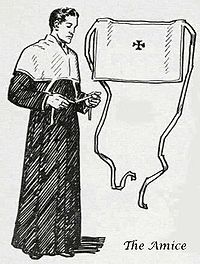
Amice
Encyclopedia

Vestment
Vestments are liturgical garments and articles associated primarily with the Christian religion, especially among Latin Rite and other Catholics, Eastern Orthodox, Anglicans, and Lutherans...
used mainly in the Roman Catholic Church, Lutheran
Lutheranism
Lutheranism is a major branch of Western Christianity that identifies with the theology of Martin Luther, a German reformer. Luther's efforts to reform the theology and practice of the church launched the Protestant Reformation...
Church, in some Anglican
Anglicanism
Anglicanism is a tradition within Christianity comprising churches with historical connections to the Church of England or similar beliefs, worship and church structures. The word Anglican originates in ecclesia anglicana, a medieval Latin phrase dating to at least 1246 that means the English...
churches, Armenian and Polish National Catholic
Polish National Catholic Church
The Polish National Catholic Church is a Christian church founded and based in the United States by Polish-Americans who were Roman Catholic. The PNCC is a breakaway Catholic Church in dialogue with the Catholic Church; it seeks full communion with the Holy See although it differs theologically...
churches. It consists of a white cloth connected to two long ribbon-like attachments, by which it is fastened around the shoulders of the priest. Before the liturgical reforms of 1972, its use was mandatory for all Roman Catholic Masses, but it is only required today if the alb
Alb
The alb , one of the liturgical vestments of the Roman Catholic, Anglican and many Protestant churches, is an ample white garment coming down to the ankles and usually girdled with a cincture. It is simply the long linen tunic used by the Romans...
does not cover the priest's
Priest
A priest is a person authorized to perform the sacred rites of a religion, especially as a mediatory agent between humans and deities. They also have the authority or power to administer religious rites; in particular, rites of sacrifice to, and propitiation of, a deity or deities...
ordinary clothing. Many priests choose to wear the amice for reasons of tradition or to prevent damage to their other vestments due to perspiration.
Certain mendicant Orders, such as the Dominicans and Franciscans, and some other orders with hooded habits, often donned the amice over the raised hood. The priest, or minister, then fastened the ribbons - crossed at the chest - behind his chest. The alb was donned over the hood/amice, and fastened. The hood/amice could then be retracted neatly around the collar.
In several Mediaeval uses, such as the Sarum Rite
Sarum Rite
The Sarum Rite was a variant of the Roman Rite widely used for the ordering of Christian public worship, including the Mass and the Divine Office...
, the amice bore a broad stiff band of brocade or other decoration, giving the impression of a high collar. These were called apparelled amices. This practice was abandoned at Rome at about the end of the 15th century, but continued in other parts of Europe until much later. By 1907, however, the practice was no longer tolerated in Roman Catholic liturgy, but still exists within many Anglican communities.
Curiously enough, this collar-like amice spread to the Armenian Church, where is retained as a normal part of the priestly vestments among the Armenian Orthodox, who call it varkas.
While donning the amice, the priest first drapes the amice over his head (as with a hood), then lowers it to his neck, tying it around his torso. During this action he prays a short prayer asking God to clothe him with the "helmet of salvation".

